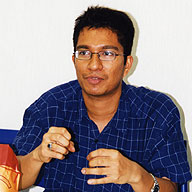An Interview with Amir Muhammad
I’m Still Not Done Talking!

Q: You have a lot of people constantly talking in your film, each with very different ways of telling stories. And you have managed to put them together like in a mosaic. Can you tell me why you chose this mosaic form?
AM: Actually, I wasn’t thinking of mosaic as such, but in Malaysia, a very popular and almost emblematic type of food is called rojak. And rojak, the closest equivalent is like chop suey where it’s a lot of different things like eggs and squid and cucumber—things that don’t seem to fit together—and you put it all together and you cover it with peanut sauce.
So that is rojak. And in Malaysia it’s sometimes used as a term for mixed race. So if you’re mixed race, sometimes people call you rojak. Sometimes it’s not meant in a polite way, but sometimes it’s almost like a compliment. So I thought this dish is very Malaysian in that sense. So to capture Malaysia, which is not a mono-cultural society, not a mono-linguistic society, I thought that would be the best approach. And it was also the approach I was going for in Lips to Lips, but I think this one was more successful than in Lips to Lips.
Q: In your film you used actors as well as real people playing themselves. Why?
AM: Partly because I’m quite interested in working with actors and creating characters. But also I think one of the reasons was that the period in October 1987 was the first time I learned to distrust what was on the news. Because what I saw around me, what people were saying, was not the same as what we were being told. There was this consciousness that some of it was acting. So I wanted to capture it, and I thought that was the most direct and interesting way to capture that.
And also it’s fun having actors. I wanted really talkative people. Because I think you have to have talking, you have to have food, you have to have cigarettes—all the finer things in life. And you know, I’m impatient with people who are sort of like “hmmm...” So rather than have these sort of people in it, I’d rather have people who have something to say and just say it.
Q: Did you come up with entirely fake characters with fake names and occupations? Because when a character is known as a “former jelly salesman,” it seems to be obviously fake.
AM: I think that type of thing is a sort of cue for a Malaysian audience because if they recognize an actor and see a different name, then they know it’s fake. But also, even though they are fake, they are all somebody’s true stories. I held auditions and people came with their stories. So that story about the M16, that actually was told to me by a former jelly salesman. It was a Japanese brand and he sold 21 brands of jelly and could name all the types of jellies. But he spoke so slowly and he took so long. It was like pulling teeth! So I just thanked him for his story and gave it to this actor! Also, I had changed his name because he was not from Sarawak and I wanted the actor to play a character from Sarawak, which is Malaysia’s largest state. It’s next to Sabah, and even though it’s the largest state, it’s very poorly represented in out media because our media is very much centered on the peninsula. A lot of people on the peninsula, when they mention Malaysia, they think only of the peninsula, they don’t think of Sabah and Sarawak at all. So I wanted a character from that state.
And my favorite occupation is of the girl who was talking about Tommy Paige. I call her a “fragrance promoter” because that’s the most annoying job I could think of. I called her up because I know that she’s good at playing annoying people—it’s like her specialty. And we actually left out most of her speech because the editor was just so annoyed looking at her that he cut her out.
(Compiled by Iyobe Kiwa, Kato Takanobu)
Interviewers: Kato Takanobu, Iyobe Kiwa / Interpreter: Fujioka Asako
Photography: Kotani Mayo / Video: Kato Takanobu / 2003-10-03 / in Tokyo
